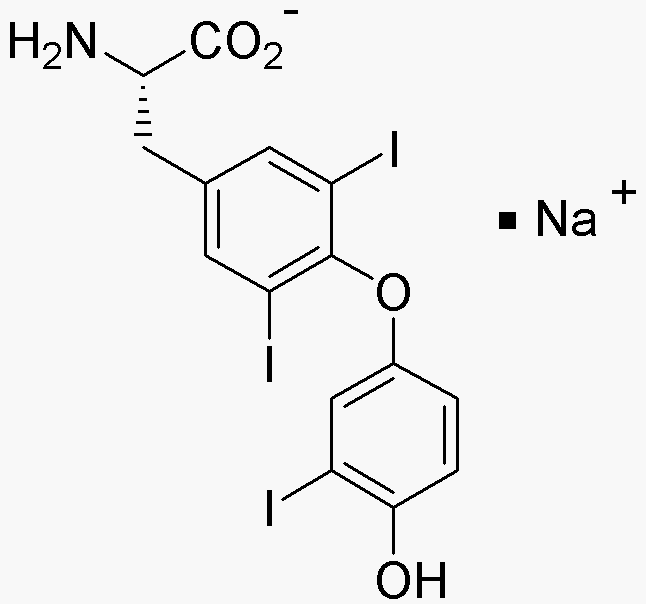3,3',5-Triiodo-L-thyronine sodium salt is widely utilized in research focused on:
- Thyroid Hormone Research: This compound is crucial for studying thyroid hormone functions and disorders, helping researchers understand conditions like hypothyroidism and hyperthyroidism.
- Pharmaceutical Development: It plays a significant role in the formulation of medications aimed at regulating metabolic rates and treating thyroid-related diseases, offering targeted therapeutic options.
- Endocrinology Studies: The compound is used in various endocrinological studies to investigate hormonal interactions and their effects on growth and metabolism, providing insights into human health.
- Animal Health: In veterinary medicine, it is applied to manage thyroid conditions in animals, ensuring better health outcomes and improved quality of life for pets and livestock.
- Research on Metabolic Disorders: This chemical aids in the exploration of metabolic syndromes, allowing scientists to develop strategies for managing obesity and diabetes through thyroid hormone modulation.
Informations générales
Propriétés
Sécurité et réglementation
Applications
3,3',5-Triiodo-L-thyronine sodium salt is widely utilized in research focused on:
- Thyroid Hormone Research: This compound is crucial for studying thyroid hormone functions and disorders, helping researchers understand conditions like hypothyroidism and hyperthyroidism.
- Pharmaceutical Development: It plays a significant role in the formulation of medications aimed at regulating metabolic rates and treating thyroid-related diseases, offering targeted therapeutic options.
- Endocrinology Studies: The compound is used in various endocrinological studies to investigate hormonal interactions and their effects on growth and metabolism, providing insights into human health.
- Animal Health: In veterinary medicine, it is applied to manage thyroid conditions in animals, ensuring better health outcomes and improved quality of life for pets and livestock.
- Research on Metabolic Disorders: This chemical aids in the exploration of metabolic syndromes, allowing scientists to develop strategies for managing obesity and diabetes through thyroid hormone modulation.
Documents
Fiches de données de sécurité (FDS)
La FDS fournit des informations de sécurité complètes sur la manipulation, le stockage et l’élimination du produit.
Spécifications du produit (PS)
Le PS fournit une description complète des propriétés du produit, notamment sa composition chimique, son état physique, sa pureté et les exigences de stockage. Il détaille également les plages de qualité acceptables et les applications prévues du produit.
Certificats d'analyse (COA)
Recherchez des certificats d'analyse (COA) en saisissant le numéro de lot du produit. Les numéros de lot et de lot se trouvent sur l'étiquette d'un produit, après les mots « Lot » ou « Lot de fabrication ».
Numéro de catalogue
Numéro de lot/série
Certificats d'origine (COO)
Ce certificat d'exploitation confirme le pays dans lequel le produit a été fabriqué, et détaille également les matériaux et composants utilisés et s'il est issu de sources naturelles, synthétiques ou autres sources spécifiques. Ce certificat peut être requis pour les douanes, le commerce et la conformité réglementaire.
Numéro de catalogue
Numéro de lot/série
Fiches de données de sécurité (FDS)
La FDS fournit des informations de sécurité complètes sur la manipulation, le stockage et l’élimination du produit.
DownloadSpécifications du produit (PS)
Le PS fournit une description complète des propriétés du produit, notamment sa composition chimique, son état physique, sa pureté et les exigences de stockage. Il détaille également les plages de qualité acceptables et les applications prévues du produit.
DownloadCertificats d'analyse (COA)
Recherchez des certificats d'analyse (COA) en saisissant le numéro de lot du produit. Les numéros de lot et de lot se trouvent sur l'étiquette d'un produit, après les mots « Lot » ou « Lot de fabrication ».
Numéro de catalogue
Numéro de lot/série
Certificats d'origine (COO)
Ce certificat d'exploitation confirme le pays dans lequel le produit a été fabriqué, et détaille également les matériaux et composants utilisés et s'il est issu de sources naturelles, synthétiques ou autres sources spécifiques. Ce certificat peut être requis pour les douanes, le commerce et la conformité réglementaire.


